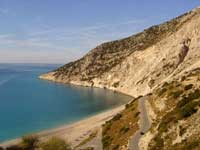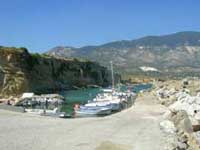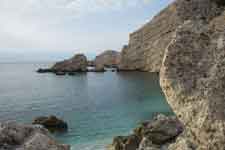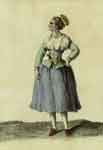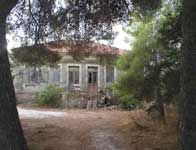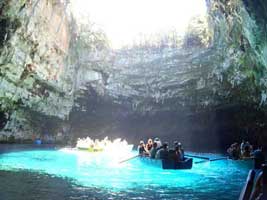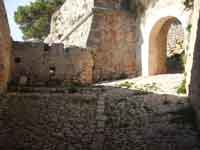.


Administrative Region : Ionian Islands
Regional unit : Kefalonia
The island of Cephalonia, also known as Kefalonia, Cephallenia, Cephallonia, Kefallinia, or Kefallonia (Ancient Greek: Κεφαλληνία; Modern Greek: Κεφαλονιά or Κεφαλλονιά; Italian: Cefalonia), is the largest of the Ionian Islands in western Greece, with an area of 781 square kilometres (302 sq mi). It is also a separate peripheral unit of the Ionian Islands Periphery, and the only municipality of the peripheral unit. The capital of Cephalonia is Argostoli.[1]
View Larger Map
Geography
Argostoli and Lixouri from the mountains
The size of the island is ca. 780 km2 (300 mi2), and the present population density is 55 people per km2 (140/mi2). The town of Argostoli has one-third of the island's inhabitants. Lixouri is the second major settlement, and the two towns together account for almost two-thirds of the prefecture's population.
Cephalonia is in the heart of an earthquake zone, and dozens of minor or unrecorded tremors occur each year. In 1953, a massive earthquake almost destroyed all settlement on the island, leaving only Fiscardo in the north untouched.
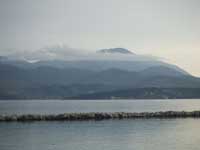
Among important natural features are the Melissani and the Drogarati caves.
Mountains
The island's highest mountain is Mount Ainos, with an elevation of 1628m; to the west-northwest are the Paliki mountains, where Lixouri is found, with other mountains including Gerania and Agia Dynati. The top of Mount Ainos is covered with Abies cephalonica trees and is a natural park.
Forestry
A poppy field.
Forestry is rare on the island; however its timber output is one of the highest in the Ionian islands, although lower than that of Elia in the Peloponnese. Forest fires were common during the 1990s and the early 2000s and still pose a major threat to the population.
Agriculture
The primary agricultural occupations are animal breeding and olive growing, with the remainder largely composed of grain and vegetables. Most vegetable production takes place on the plains, which cover less than 15% of the island, most of which is rugged and mountainous, suitable only for goats. Less than a quarter of the island's land is arable.
Until the 1970s most Cephalonians lived in rural areas, while today the urban population accounts for two-thirds, with the other third in rural towns and villages close to farmland.
Harbours and ports
Fiscardo in the northern part of the island.
There are five harbours and ports in the prefecture: four main harbours on the island, Same or Sami, and a major port with links to Patras and Ithaca. Poros, in the south, has ferry routes to Kyllini; Argostoli, in the west, is the largest port, for local boats and ferries to Zante and regularly to Lixouri; Fiscardo, in the north, has links to Lefkas and Ithaca. There is room for about 100 small boats in Argostoli, where the port stretches 1 kilometre around the bay, while Lixouri is situated 4 km across the bay from Argostoli, on the Lixouri peninsula. There is a road connection to the rest of the island, but driving from Lixouri to Argostoli involves a 30 km detour.
Capes
Cape Agios Georgios (approximate coordinates 38.1667°N 20.43333°E)
Cape Kounopetra
Cape Atheras (North-West corner of island)
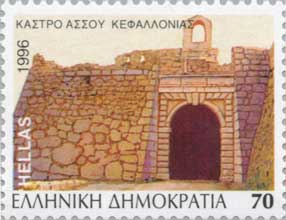
Castle of Assos, Venetian fortress from the 16th century.
Wildlife
Cephalonia is well known for its endangered loggerhead turtle population which nest at Kaminia beach under the watchful protection of the Sea Turtle Protection society.[2]
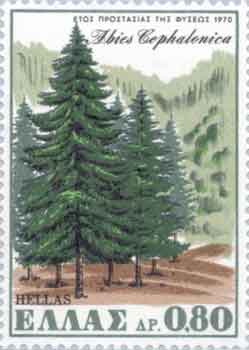
Administration
Cephaloniais a separate peripheral unit of the Ionian Islands Periphery, and the only municipality of the peripheral unit. The seat of administration is Argostoli, the main town of the island. As a part of the 2011 Kallikratis government reform, the peripheral unit Kefallinia was created out of the former Kefalonia and Ithaca Prefecture. At the same reform, the current municipality Cephalonia was created out of the 8 former municipalities:[1]
Argostoli the capital
Paliki peninsula with its main town Lixouri
Sami the third largest town and most important port
Erisos with the harbours of Fiscardo and Assos
Eleios-Pronnoi with the harbour of Poros and Skála
Leivathos the valley south of Argostoli
Omala the valley at the monastery of Saint Gerasimos
Pylaros with the harbour Agia Evfimia and the beach of Myrtos
History
Legend
An aition explaining the name of Cephallenia and reinforcing its cultural connections with Athens associates the island with the mythological figure of Cephalus, who helped Amphitryon of Mycenae in a war against the Taphians and Teleboans.[3] He was awarded with the island of Same, which thereafter came to be known as Cephallenia.
Cephalonia has also been suggested as the Homeric Ithaca, the home of Odysseus, rather than the smaller island bearing this name today. Robert Bittlestone, in his book Odysseus Unbound, has suggested that Paliki, now a peninsula of Cephalonia, was a separate island during the late Bronze Age, and it may be this that Homer was referring to when he described Ithaca. A project starting in the Summer of 2007, and lasting three years examines this possibility.[4]
Cephalonia is also referenced in relation to the goddess Britomartis, as the location where she is said to have 'received divine honours from the inhabitants under the name of Laphria'.
Archaeology
Coins from Pale/Pali the ancient town north of Lixouri.
In the Southwest of the island, in the area of Leivatho, an ongoing archaeological field survey by the Irish Institute at Athens has discovered dozens of sites, with dates ranging from the Palaeolithic to the Venetian period.
From archaeological point of view Cephalonia is an extremely interesting island. Archaeological findings go back to 40,000 BP. Without any doubt the island's most important era is the Mycenaean era from approx. 1500-1100 B.C. The archaeological museum in Cephalonia’s capital Argostoli – although small – is regarded as the most important museum in Greece for its exhibits from this era. http://www.leepka.gr/mouseioarg.php
The most important archaeological discovery in Cephalonia (and in Greece) of the past twenty years was the discovery in 1991 of the Mycenaean tholos tomb at the outskirts of the village Tzanata, near Poros, Kefalonia in south-eastern Cephalonia (Municipality of Elios-Pronni) in a lovely setting of olive trees, cypresses and oaks. The tomb was erected around 1300 B.C. Kings and high ranked officials were buried in these tholos tombs during the Mycenaean period. It is the biggest tholos-tomb yet found in north-western Greece. The tomb was excavated by the archaeologist Lazaros Kolonas. The size of the tomb, the nature of the burial offerings found there and its well-chosen position point to the existence of an important Mycenaean town in the vicinity.
In late 2006, a Roman grave complex was uncovered as excavations took place for the construction of a new hotel in Fiscardo. The remains date to the period between the 2nd century B.C. and the 4th century A.D. Archaeologists described this as the most important find of its kind ever made in the Ionian Islands. Inside the complex five burial sites were found, including a large vaulted tomb and a stone coffin, along with gold earrings and rings, gold leaves which may have been attached to ceremonial clothing, glass and clay pots, bronze artefacts decorated with masks, a bronze lock and bronze coins. The tomb had escaped the attentions of grave robbers and remained undisturbed for thousands of years. In a tribute to Roman craftsmanship, when the tomb was opened the stone door swung easily on its stone hinges. Very near to the tomb a Roman theatre was discovered, so well preserved that the metal joints between the seats were still intact.
Monasteries
Across the broader island, two large monasteries are to be found: the first is that of Haghia Panagia, in Markopoulo to the southeast, and the other lies on the road between Argostoli and Michata, on a small plain surrounded by mountains. This second has an avenue of about 200 trees aligned from NW to SE, with a circle in the middle, and is the monastery of Saint Gerasimus of Kefalonia, patron saint of the island, whose relics can be seen and venerated at the old church of the monastery.
Venetian rule
Cephalonia born Greeks of the 18th century. Petros Melissinos (ca. 1726 – 1797) (left) and Spiridonos Louzis ( ca. 1741 – 1815) (right).[5]
During the Middle Ages, the island was the center of the Byzantine theme of Cephallenia. After 1185 it became part of the County palatine of Cephalonia and Zakynthos under the Kingdom of Naples until its last Count Leonardo III Tocco was defeated by the Ottomans in 1479. The Turkish rule lasted only until 1500, when it was captured by a Spanish-Venetian army, a rare Venetian success in the Ottoman–Venetian War (1499–1503). From then on Cephalonia and Ithaca remained overseas colonies of the Venetian Republic until its very end, following the fate of the Ionian islands, completed by the capture of Lefkas from the Turks in 1684. The Treaty of Campoformio dismantling the Venetian Republic awarded the Ionian Islands to France, a French expeditionary force with boats captured in Venice taking control of the islands in June 1797.
From the 16th to the 18th centuries, it was one of the largest exporters of currants in the world together with Zakynthos and owned a large shipping fleet, even commissioning ships from the Danzig shipyard. The towns and villages mostly were built high on hilltops, to prevent attacks from raiding parties of pirates that sailed the Ionian sea during the 1820s.
French, Ionian state period and British Rule
From 1797 to 1798, the island was part of the French départment Ithaque. From 1799 to 1807, it was part of the Septinsular Republic, nominally under sovereignty of the Ottoman Empire but protected by Russia. After a second period under French control (1807–1809), it was conquered by Great-Britain in October 1809 and became a dependency of the British Empire, named the United States of the Ionian Islands from 1815 to 1864.
Union with Greece
In 1864, Cephalonia, together with all the other Ionian Islands, became a full member of the Greek state.
World War II
Further information: Axis occupation of Greece during World War II
In World War II, the island was occupied by Axis powers. Until late 1943, the occupying force was predominantly Italian - the 33rd Infantry Division Acqui plus Navy personnel totalled 12,000 men - but about 2,000 troops from Nazi Germany were also present. The island was largely spared the fighting, until the armistice with Italy concluded by the Allies in September 1943. Confusion followed on the island, as the Italians were hoping to return home, but German forces did not want the Italians' munitions to be used eventually against them; Italian forces were hesitant to turn over weapons for the same reason. As German reinforcements headed to the island the Italians dug in and, eventually, after a referendum among the soldiers as to surrender or battle, they fought against the new German invasion. The fighting came to a head at the siege of Argostoli, where the Italians held out. Ultimately the German forces prevailed, taking full control of the island, and five thousand of the nine thousand surviving Italian soldiers were executed as a reprisal by German forces. While the war ended in central Europe in 1945, Cephalonia remained in a state of conflict due to the Greek Civil War. Peace returned to Greece and the island in 1949.
The Great Earthquake of 1953
Main article: 1953 Ionian Earthquake
Cephalonia is just to the east of a major tectonic fault, where the European plate meets the Aegean plate at a slip boundary. This is similar to the more famous San Andreas Fault. There are regular earthquakes along this fault.
A series of four earthquakes hit the island in August 1953, and caused major destruction, with virtually every house on the island destroyed. The third and most destructive of the quakes took place on August 12, 1953 at 09:24 UTC (11:24 local time), with a magnitude of 7.3 on the Richter scale. Its epicentre was directly below the southern tip of Cephalonia, and caused the entire island to be raised 60 cm higher, where it remains, with evidence in water marks on rocks around the coastline.
This 1953 disaster caused huge destruction, with only regions in the north escaping the heaviest tremors and houses there remaining intact. Damage was estimated to run into tens of millions of dollars, equivalent to billions of drachmas, but the real damage to the economy occurred when residents left the island. An estimated 100,000 of the population of 125,000 left the island soon after, seeking a new life elsewhere.
Recent history
The seat of the united Cephalonia municipality.
The forest fire of the 1990s caused damage to the island's forests and bushes, especially a small scar north of Troianata, and a large area of damage extending from Kateleios north to west of Tzanata, ruining about 30 square kilometres of forest and bushes and resulting in the loss of some properties. The forest fire scar was seen for some years.
In mid-November 2003, an earthquake measuring 5.3 on the Richter scale caused minor damage to business, residential property, and other buildings within the Argostoli periphery. Damages were in the €1,000,000 range.
On the morning of Tuesday September 20, 2005, an early-morning earthquake shook the south-western part of the island, especially near Lixouri and its villages. The earthquake measured 4.9 on the Richter scale, and its epicentre was located off the island at sea. Service vehicles took care of the area, and no damage was reported.
Between January 24 and 26 of 2006, a major snowstorm blanketed the entire island, causing extensive blackouts.
The island was recently struck yet again by another forest fire in the south of the island, beginning on Wednesday July 18, 2007 during an unusual heatwave, and spreading slowly. Firefighters along with helicopters and planes battled the blaze for some days and the spectacle frightened residents on that area of the island. The fire later burnt out, having consumed thousands of hectares of forests and bushes. It transformed a natural beauty into an undemanding scenery.
Population
In the ancient period, before it was named Cephalonia or Kefalonia, the island's population was only between one hundred and three hundred; by the time of the founding of Cephalonia, the population had trebled to between 500 and 1,000. It grew steadily, reaching 10,000 in the mid-20th century and 20,000 by the 1970s. During the 1990s, due to new construction, the island had the fastest increasing population in Greece, with a growth rate of between 35 and 40 per cent. The total was 36,404 at the census of 2001 and by 2010 was estimated to be approaching 45,000.
Most of the indigenous people of Cephalonia have surnames ending in "-atos", and almost every community on the island has a name ending in "-ata", such as Valsamata, Frangata, Lourdata, Favata, Delaportata, and others.
Economy
Tourism
Tourists and locals dining on the Square Vallianos in Argostoli.
A large number of tourists visit Cephalonia during the peak season but, as one of the largest islands in Greece, it is well-equipped to handle visitors. Most tourists stay in or around Lassi, a serene resort a few kilometres from Argostoli and in the villages Skala and Katelios in the Municipality of Elios-Pronni. Their numbers have increased since the best-seller, Captain Corelli's Mandolin, was made a film (2001) shot on the island itself. Many people from all over Greece and the world visit Cephalonia. Many tourists come from Italy mostly because of its close location.
Olive oil production
Olive oil production is a major component of Cephalonia's economy. Until the 18th Century the quantity of olive oil produced on the island just covered the needs of the residents. However, the pressure of Venetian conquerors’ for olive plantation, especially after the loss of Peloponnese and Crete resulted in increasing the production to such a degree that the first exports to Venice began. Before the 1953 Ionian Earthquake, there were 200 oil presses operating on the island; today, there are thirteen. There are over one million olive trees on Cephalonia, covering almost 55% of the island's area. Olive oil is very important to the island's local, rural economy. “Koroneiki” and “theiako” are the two main varieties cultivated on the island and followed by a smaller number are “ntopia” and “matolia”. Kefalonian olive oil has a green tone, a rich, greasy touch, and low acidity.
Culture
Literature and film
Perhaps the best known appearance of Cephalonia in popular culture is in the novel Captain Corelli's Mandolin, by English author Louis de Bernières. The book is believed to be inspired by the picturesque village of Farsa, just outside of Argostoli. The love story comprising the theme of the book is set before and after the Acqui Division massacre,[6] during the Second World War, and the film adaptation was released in 2001.
During filming there was lively debate between the production team, local authorities as well as groups of citizens, as to the complex historical details of the island's antifascist resistance. As a result political references were omitted from the film, and the romantic core of the book was preserved, without entering complex debates around the island's history. In 2005 Ennio Morricone made his film Cefalonia, also about the massacre.
Museums
Korgialeneios Museum (under the Korgialeneios Library) in Argostoli
Kosmetatos Foundation in Argostoli
Archaeological Museum in Argostoli
Iakovatios-Library in Lixouri
Museum in Fiscardo
Recreation
The famous Myrtos Beach.
The island is covered by dense vegetation and offers a great range of natural beauty, including beaches—many of them inaccessible from land—and spectacular caves. Mirtos, the most famous of these beaches, is a major tourist attraction, and has been ranked fifth worldwide for its beauty. Fishing is very common throughout the waters within and around the island, and the harbours of Argostoli and Lixouri are the main fishing centres. Overfishing can be a problem in Cephalonia, and in the Ionian area generally.
Notable people
Antiquity
Cephalus, Hero-figure in Greek mythology, Patriarch of all Cephalonians (cephallenians)
Odysseus of Ithaca, king of the Cephalonians
Epiphanes, was born on Cephalonia in the late 1st Century or early 2nd Century to Carpocrates (his father), and Alexandria of Cephallenia. He is the legendary author of On Righteousness, a notable Gnostic literary work that promotes communist principles.
Gaius Antonius Hybrida, the uncle of the famed triumvir Mark Antony and co-consul of Cicero was exiled to Cephalonia in 59 BC.
Middle Ages - 1800
Juan de Fuca (Ioannis Phokas) (1536–1602), captain and explorer
Constantine Phaulkon (1647–1688), adventurer, first counsellor to King Narai of Ayutthaya
Giacomo Pylarini, Doctor (1659–1718), gave the first smallpox inoculation outside of Turkey and contributed to the later development of vaccination against smallpox, by Edward Jenner.
Joannicus and Sophronius Likhud, born on Cephalonia, Organized in 1685-1687 the Slavic Greek Latin Academy, Славяно-греко-латинская академия in Russian) which was the first higher education establishment in Moscow, Russia.
Vikentios Damodos (1700–1752), renowned 18th century Greek philosopher
Marinos Carburis ( 1729 - 1782), Engineer, Undertook the project to move the "Thunder Stone" Bronze Horseman'S pedestal, the largest stone ever moved by man
Andreas Metaxas (Greek: Ανδρέας Μεταξάς)(1786 - September 19, 1860), prime minister of Greece born on the island of Cephalonia.
Spiridonos Louzis (Greek: Σπυρίδωνος Λούζης) ( ca. 1741 – 1815), Greek scholar, diplomat, politician and naturalized ambassador of Prussia.[5]
Petros Melissinos Greek: Πέτρος Μελισσηνός)(ca. 1726 – 1797) was a General of the Army of the Russian Empire and was widely considered the best Russian artilleryman of the 18th century.[7]
1800 - Recent Past
Panayis Athanase Vagliano, Greek: Παναγής Βαλλιάνος a.k.a. Panaghis Athanassiou Vallianos, (1814–1902) was a merchant and shipowner, acclaimed as the 'father of modern Greek shipping.
Charles Denis Sauter Bourbaki (22 April 1816 – 27 September 1897) was a French general.
Nikolaos Xydias Typaldos (1826–1909), painter
Photinos Panas, (January 30, 1832–1903) ophthalmologist, born on the Greek island of Cephalonia, Spartia. In 1860 he obtained his medical degree at Paris. He was the first professor of ophthalmology at the University of Paris, and in 1879 established the ophthalmology clinic at the Hôtel-Dieu de Paris.
Grigory Ivanovich Rossolimo, (December 17 [O.S. December 5] 1860 - September 1928) was a Russian neurologist of Cephalonian origin. In 1917 he attained the chair of neuropathology-University of Moscow. Rossolimo's reflex, is a neurological sign named after him.
Panait Istrati,(August 10, 1884—April 18, 1935) was a Romanian writer of French and Romanian expression, nicknamed The Maxim Gorky of the Balkans. was the son of the laundress Joiţa Istrate and of a smuggler from Cephalonia (Panait never met him).
Ioannis Metaxas (April 12, 1871 – January 29, 1941),General, appointed Prime Minister of Greece between April and August 1936, and dictator during the 4th of August Regime, from 1936 until his death in 1941.
Marinos Antypas (1872–1907), lawyer and journalist, one of the country's first socialists
Christian Zervos 1889–1970) art collector, writer and publisher
Mikelis Avlichos (1844–1917) famous Greek Anarchist from Lixouri
Recent Past - Present
Spyridon Marinatos (1901–1974), archaeologist
Antiochos Evangelatos (1903–1981), composer and conductor
Nikolaos Platon (1909–1992), archaeologist
Nikos Kavadias (1910–1975), poet and author
Nicolas Rossolimo (Nikolai Spiridonovich Rossolimo) (1910–1975), was an American-French-Russian-Greek chess Grandmaster. His Greek ancestors were from Cephalonia.
Nikolay Todorov, (1921–2003), Of Cephalonian origin, Acting President of Bulgaria (1990)
Gerassimos Sclavos (1927-1967), Sculptor
Archbishop Anastasios of Albania (1929- ), of Cephalonian origin
Gerasimos D. Arsenis, (1931- ) politician, former minister of Finance, Defense and Education.
Spyros Troianos, (1933- ) Professor of law, former rector of the Ionian University
Antonis Tritsis (1937–1992), politician, mayor of Athens
Andreas Gerasimos Michalitsianos (1947–1997), Greek-American astronomer and a NASA astrophysicist
John Varvatos, fashion designer
Nikolas - Chris G. Markatos, (1944- ) Professor of Chemical Engineering at the National Technical University of Athens, former rector of the university
Antonios Maratos, (1933-), celebrity stylist and haircutter
Aleka Papariga, (1945- ), of Cephalonian origin, Leader of the Greek communist party
Archie Karas (1950-), a Greek gambler known for turning $50 into $40 million before losing it all
Andreas Tzakis M.D.,the first person in history to successfully transplant eight organs in a single operation
Gerasimos D. Danilatos, physicist and inventor of environmental scanning electron microscope
Athanassios S. Fokas, Department of Applied Mathematics and Theoretical Physics, University of Cambridge
Norman St John-Stevas, Baron St John of Fawsley, of Cephalonian origin
Andreas Loverdos (1956- ),lawyer and politician of Cephalonian origin, Minister for Employment and Social Security, Minister for Health and Social Solidarity.
Mariliza Xenogiannakopoulou (1963- ),of Cephalonian origin, Member of the European Parliament, Minister for Health and Social Solidarity
Pavlos Geroulanos, (1966- ), of Cephalonian origin, Minister of culture
Sofia Bekatorou,(1977-), of Cephalonian origin, gold medal in the women's double-handed dinghy in the 470 with her pair Emilia Tsoulfa Summer Olympics 2004
Anna Pollatou a rhythmic gymnast. She won a bronze medal at the 2000 Summer Olympics.
Nikos Prekas writer of History of an ancient island
Sports
baseball
AINOS Kefalonia
cycling
AINOS Kefalonia podilatikos omilos 26710-25029
Football
See also: Kefalonia-Ithaca Football Clubs Association
A.O. Anogi - Anogi
Argostoli A.U. - Argostoli
Asteras Lixouri - Lixouri
Asteras Z
Dilinata AU - Dilinata
Efgeros Faraklades Argostili - Argostoli
Ikossimias AU
Kefalliniakos
Kefalonia-Ithaca
Leivatho A.U. - Leivathos
Lixouri A.U. - Lixouri
Olympiaki Floga - Olympic Flame
Olympiakos Argostoli - Argostoli
Pagkefalliniakos
Pallixouriakos A.C.
Papavrgiakos
PAO Kefalos
Pylariakos - Pylaros
Proodos Ithaki - Ithaca
Sami AU - Sami
Others
Nautical Racing Club of Kefalonia and Ithaca
Transportation
Roads
The first larger roads were built by the English in the 19th century. In the 20th century asphalted roads were built, and since 1995 almost all streets connecting villages and beaches are covered with asphalt. since ca. 2000 the Lixouri bypass was built and a four lane street south of Argostoli was constructed. Some important roads include:
Greek National Road 50, commonly Argostoli-Sami Road
Argostoli-Poros Road
Argostoli-Fiskardo Road (with link to Lixouri)
Road linking Poros and Sami
Airport
Cephalonia has one airport, Kefalonia Island International Airport, with a runway around 2.4 km. in length, located about 10 km south of Argostoli. Almost every scheduled flight is an Olympic route, flying mainly to and from Athens, although there is an Ionian Island Hopper www.airsealines.com service 3 times a week calling at Cephalonia, Zante and Lefkas. In summer the airport handles a number of charter flights from all over Europe.
Higher education
Technical Educational Institution of the Ionian Islands, Argostoli Campus (Department of Biological Agriculture and Department of Public Relations and Communication)
Technical Educational Institution of the Ionian Islands, Lixouri Campus (Department of Business Administration & Music instruments and Department of Business Administration)
National Merchant Marine Academy, Argostoli
The Music School of Kefalonia - Rokos Vergotis Conservatory, Argostoli
Further reading
Acta Archaeologica - volume 73/2 (December 2002) is a special issue dealing with the archaeology of Kephallénia.
See also
List of settlements in the Kefalonia and Ithaka prefecture
Municipality Kefalonia(Seat: Αργοστόλι το) |
3501 | 35.801 |
|---|---|---|
| Municipal unit Argostoli | 350101 | 13.237 |
| Municipal Community Argostoli | 35010101 | 10.633 |
| Argostoli (Αργοστόλι το) | 3501010101 | 9.748 |
| Kokolata (Κοκολάτα τα) | 3501010102 | 176 |
| Kompothekrata (Κομποθεκράτα τα) | 3501010103 | 449 |
| Minia (Μηνιά η) | 3501010104 | 260 |
| Community Agkonas | 35010102 | 159 |
| Agkonas (Αγκών ο) | 3501010201 | 159 |
| Community Davgata | 35010103 | 66 |
| Davgata (Δαυγάτα τα) | 3501010301 | 66 |
| Community Dilinata | 35010104 | 496 |
| Dilinata (Διλινάτα τα) | 3501010401 | 496 |
| Community Zola | 35010105 | 101 |
| Zola (Ζόλα τα) | 3501010501 | 101 |
| Community Thinaia | 35010106 | 169 |
| Kardakata (Καρδακάτα τα) | 3501010601 | 169 |
| Community Kourouklata | 35010107 | 76 |
| Kourouklata (Κουρουκλάτα τα) | 3501010701 | 76 |
| Community Nyfio | 35010108 | 41 |
| Nyfio (Νύφιον το) | 3501010801 | 41 |
| Community Troianata | 35010109 | 223 |
| Demoutsantata (Δεμουτσαντάτα τα) | 3501010902 | 109 |
| Mitakata (Μιτακάτα τα) | 3501010903 | 16 |
| Troianata (Τρωιανάτα τα) | 3501010901 | 98 |
| Community Faraklata | 35010110 | 1.058 |
| Drapano (Δράπανον το) | 3501011002 | 135 |
| Prokopata (Προκοπάτα τα) | 3501011003 | 86 |
| Razata (Ραζάτα τα) | 3501011004 | 507 |
| Faraklata (Φαρακλάτα τα) | 3501011001 | 330 |
| Community Farsa | 35010111 | 215 |
| Farsa (Φάρσα τα) | 3501011101 | 215 |
| Municipal unit Eleios-Pronnoi | 350102 | 3.677 |
| Municipal Community Poros | 35010209 | 1.176 |
| Asprogerakas (Ασπρογέρακας ο) | 3501020902 | 12 |
| Kampitsata (Καμπιτσάτα τα) | 3501020903 | 41 |
| Moni Yperageias Theotokou Atrou (Μονή Υπεραγίας Θεοτόκου Άτρου η) | 3501020904 | 0 |
| Poros (Πόρος ο) | 3501020901 | 930 |
| Riza (Ρίζα η) | 3501020905 | 34 |
| Tzanata (Τζανάτα τα) | 3501020906 | 159 |
| Community Agia Eirini | 35010202 | 314 |
| Agia Eirini (Αγία Ειρήνη η) | 3501020201 | 314 |
| Community Agios Nikolaos | 35010203 | 96 |
| Agios Nikolaos (Άγιος Νικόλαος ο) | 3501020301 | 96 |
| Community Arginia | 35010204 | 15 |
| Arginia (Αργίνια τα) | 3501020401 | 15 |
| Community Valerianos | 35010205 | 302 |
| Atsoupades (Ατσουπάδες) | 3501020502 | 97 |
| Valerianos (Βαλεριάνος ο) | 3501020501 | 154 |
| Plateies (Πλατείαι αι) | 3501020503 | 51 |
| Community Markopoulo | 35010206 | 277 |
| Kateleios (Κατελειός ο) | 3501020602 | 36 |
| Kato Kateleios (Κάτω Κατελειός ο) | 3501020603 | 156 |
| Markopoulo (Μαρκόπουλον το) | 3501020601 | 85 |
| Community Mavrata | 35010207 | 139 |
| Mavrata (Μαυράτα τα) | 3501020701 | 139 |
| Community Xenopoulo | 35010208 | 108 |
| Andriolata (Ανδριολάτα τα) | 3501020802 | 8 |
| Kapandriti (Καπανδρίτιον το) | 3501020803 | 50 |
| Xenopoulo (Ξενόπουλον το) | 3501020801 | 50 |
| Community Pastra | 35010201 | 173 |
| Kremmydi (Κρεμμύδιον το) | 3501020102 | 40 |
| Pastra (Πάστρα η) | 3501020101 | 133 |
| Community Skala | 35010210 | 923 |
| Aleimmatas (Αλειμματάς ο) | 3501021002 | 20 |
| Ratzakli (Ρατζακλίον το) | 3501021003 | 118 |
| Skala (Σκάλα η) | 3501021001 | 760 |
| Fanies (Φανιές οι) | 3501021004 | 25 |
| Community Chionata | 35010211 | 154 |
| Thiramonas (Θηράμονας ο) | 3501021102 | 59 |
| Kolaitis (Κολαίτης ο) | 3501021103 | 32 |
| Chionata (Χιονάτα τα) | 3501021101 | 63 |
| Municipal unit Erisos | 350103 | 1.472 |
| Community Antipata Erisou | 35010302 | 191 |
| Antipata (Αντιπάτα τα) | 3501030201 | 149 |
| Germenata (Γερμενάτα τα) | 3501030202 | 36 |
| Psilithrias (Ψιλιθριάς ο) | 3501030203 | 6 |
| Community Asos | 35010303 | 88 |
| Asos (Άσος η) | 3501030301 | 88 |
| Community Vary | 35010304 | 36 |
| Vary (Βαρύ το) | 3501030401 | 36 |
| Community Vasilikades | 35010301 | 130 |
| Vasilikades ( Βασιλικιάδες αι) | 3501030101 | 106 |
| Konidarata (Κονιδαράτα τα) | 3501030102 | 24 |
| Community Karya | 35010305 | 28 |
| Karya (Καρυά η) | 3501030501 | 28 |
| Community Kothreas | 35010306 | 80 |
| Defaranata (Δεφαρανάτα τα) | 3501030602 | 14 |
| Drapanitika (Δραπανίτικα τα) | 3501030603 | 2 |
| Kothreas (Κοθρέας ο) | 3501030601 | 60 |
| Kokolata (Κοκολάτα τα) | 3501030604 | 4 |
| Community Komitata | 35010307 | 73 |
| Agia Sofia (Αγία Σοφία η) | 3501030702 | 10 |
| Komitata (Κομιτάτα τα) | 3501030701 | 63 |
| Community Mesovounia | 35010308 | 74 |
| Mesovounia (Μεσοβούνια τα) | 3501030801 | 74 |
| Community Neochori | 35010309 | 38 |
| Neochori (Νεοχώρι το) | 3501030901 | 38 |
| Community Patrikata | 35010310 | 33 |
| Patrikata (Πατρικάτα τα) | 3501031001 | 33 |
| Community Plagia | 35010311 | 70 |
| Plagia (Πλαγιά η) | 3501031101 | 70 |
| Community Touliata | 35010312 | 336 |
| Agrilias (Αγριλιάς ο) | 3501031202 | 44 |
| Ventourata (Βεντουράτα τα) | 3501031203 | 30 |
| Vigli (Βιγλί το) | 3501031204 | 31 |
| Manganos (Μάγγανος ο) | 3501031205 | 69 |
| Markoulata (Μαρκουλάτα τα) | 3501031206 | 51 |
| Tzamarellata (Τζαμαρελλάτα τα) | 3501031207 | 50 |
| Touliata (Τουλιάτα τα) | 3501031201 | 22 |
| Chalikeri (Χαλικερή η) | 3501031208 | 39 |
| Community Fiskardo | 35010313 | 295 |
| Asteris (Αστερίς η (νησίς)) | 3501031302 | 0 |
| Evreti (Ευρετή η) | 3501031303 | 14 |
| Katsarata (Κατσαράτα τα) | 3501031304 | 20 |
| Matsoukata (Ματσουκάτα τα) | 3501031305 | 28 |
| Tselentata (Τσελεντάτα τα) | 3501031306 | 44 |
| Fiskardo (Φισκάρδον το) | 3501031301 | 189 |
| Municipal unit Leivathos | 350104 | 5.745 |
| Community Vlachata Eikosimias | 35010402 | 853 |
| Vlachata (Βλαχάτα τα) | 3501040201 | 699 |
| Simotata (Σιμωτάτα τα) | 3501040202 | 154 |
| Community Karavados | 35010403 | 432 |
| Karavados (Καραβάδος ο) | 3501040301 | 432 |
| Community Kerameies | 35010401 | 334 |
| Kerameies (Κεραμειαί αι) | 3501040101 | 334 |
| Community Lakithra | 35010404 | 662 |
| Lakithra (Λακήθρα η) | 3501040401 | 613 |
| Menegata (Μενεγάτα τα) | 3501040402 | 49 |
| Community Lourdata | 35010405 | 170 |
| Lourdata (Λουρδάτα τα) | 3501040501 | 170 |
| Community Metaxata | 35010406 | 504 |
| Metaxata (Μεταξάτα τα) | 3501040601 | 504 |
| Community Mousata | 35010407 | 318 |
| Mousata (Μουσάτα τα) | 3501040701 | 318 |
| Community Peratata | 35010408 | 800 |
| Kastro (Κάστρον το) | 3501040802 | 44 |
| Moni Agiou Andreou (Μονή Αγίου Ανδρέου η) | 3501040803 | 5 |
| Peratata (Περατάτα τα) | 3501040801 | 751 |
| Community Pesada | 35010409 | 407 |
| Dorizata (Δοριζάτα τα) | 3501040902 | 111 |
| Kountourata (Κουντουράτα τα) | 3501040903 | 63 |
| Pesada (Πεσάδα η) | 3501040901 | 233 |
| Community Svoronata | 35010410 | 710 |
| Svoronata (Σβορωνάτα τα) | 3501041001 | 710 |
| Community Spartia | 35010411 | 555 |
| Kleismata (Κλείσματα τα) | 3501041102 | 79 |
| Korianna (Κοριάννα τα) | 3501041103 | 63 |
| Spartia (Σπαρτιά τα) | 3501041101 | 413 |
| Municipal unit Omala | 350105 | 840 |
| Municipal Community Omala | 35010501 | 840 |
| Άγιοι Απόστολοι Βαλσαμάτων οι | 3501050102 | 4 |
| Άγιος Ελευθέριος ο | 3501050103 | 0 |
| Valsamata (Βαλσαμάτα τα) | 3501050101 | 763 |
| Epanochori (Επανωχώρι το) | 3501050104 | 33 |
| Michata (Μιχάτα τα) | 3501050105 | 25 |
| Μονή Αγίου Γερασίμου η | 3501050106 | 15 |
| Municipal unit Paliki | 350106 | 7.098 |
| Municipal Community Lixouri | 35010601 | 4.301 |
| Agios Vasileios (Άγιος Βασίλειος ο) | 3501060102 | 197 |
| Agios Dimitrios (Άγιος Δημήτριος ο) | 3501060103 | 136 |
| Lepeda (Λέπεδα τα) | 3501060104 | 14 |
| Lixouri (Ληξούριον το) | 3501060101 | 3.752 |
| Longos (Λογγός ο) | 3501060105 | 64 |
| Loukerata (Λουκεράτα τα) | 3501060106 | 77 |
| Michalitsata (Μιχαλιτσάτα τα) | 3501060107 | 61 |
| Community Agia Thekli | 35010602 | 235 |
| Agia Thekli (Αγία Θέκλη η) | 3501060201 | 211 |
| Kalata (Καλάτα τα) | 3501060202 | 24 |
| Community Atheras | 35010603 | 129 |
| Atheras (Αθέρας ο) | 3501060301 | 129 |
| Community Damoulianata | 35010604 | 135 |
| Damoulianata (Δαμουλιανάτα τα) | 3501060401 | 135 |
| Community Kaminarata | 35010605 | 219 |
| Kaminarata (Καμιναράτα τα) | 3501060501 | 218 |
| Moni Yperageias Theotokou Kipouraion (Μονή Υπεραγίας Θεοτόκου Κηπουραίων η) | 3501060502 | 1 |
| Community Katogi | 35010606 | 377 |
| Vardianoi (Βαρδιάνοι οι (νησίς)) | 3501060602 | 0 |
| Vouni (Βουνίον το) | 3501060603 | 157 |
| Mantzavinata (Μαντζαβινάτα τα) | 3501060601 | 220 |
| Community Kontogenada | 35010607 | 92 |
| Kontogenada (Κοντογενάδα η) | 3501060701 | 92 |
| Community Kouvalata | 35010608 | 227 |
| Kouvalata (Κουβαλάτα τα) | 3501060802 | 59 |
| Livadi (Λιβάδιον το) | 3501060801 | 168 |
| Community Monopolata | 35010609 | 117 |
| Dellaportata (Δελλαπορτάτα τα) | 3501060902 | 11 |
| Monopolata (Μονοπολάτα τα) | 3501060901 | 94 |
| Parisata (Παρισάτα τα) | 3501060903 | 12 |
| Community Rifi | 35010610 | 62 |
| Rifi (Ρίφιον το) | 3501061001 | 62 |
| Community Skineas | 35010611 | 140 |
| Vlychata (Βλυχάτα τα) | 3501061102 | 60 |
| Skineas (Σκινέας ο) | 3501061101 | 80 |
| Community Soullaroi | 35010612 | 335 |
| Soullaroi (Σουλλάροι οι) | 3501061201 | 335 |
| Community Fovatata | 35010613 | 130 |
| Favatata (Φαβατάτα τα) | 3501061301 | 130 |
| Community Chavdata | 35010614 | 379 |
| Chavdata (Χαβδάτα τα) | 3501061401 | 379 |
| Community Chavriata | 35010615 | 220 |
| Chavriata (Χαβριάτα τα) | 3501061501 | 220 |
| Municipal unit Pylareon | 350107 | 1.391 |
| Community Agia Efimia | 35010701 | 600 |
| Agia Efimia (Αγία Ευφημία η) | 3501070101 | 432 |
| Apasa (Άπασα η (νησίς)) | 3501070102 | 0 |
| Girovaris (Γηρόβαρης ο (νησίς)) | 3501070103 | 0 |
| Drakopoulata (Δρακοπουλάτα τα) | 3501070104 | 18 |
| Kalogiros (Καλόγηρος ο (νησίς)) | 3501070105 | 0 |
| Lamprinos (Λαμπρινός ο (νησίς)) | 3501070106 | 0 |
| Modio (Μόδιο το (νησίς)) | 3501070107 | 0 |
| Xiropotamos (Ξηροπόταμος ο) | 3501070108 | 4 |
| Petalas (Πεταλάς ο (νησίς)) | 3501070109 | 0 |
| Pistros (Πίστρος ο (νησίς)) | 3501070110 | 0 |
| Praso (Πράσο το (νησίς)) | 3501070111 | 0 |
| Sofia (Σοφία η (νησίς)) | 3501070112 | 0 |
| Soros (Σωρός η (νησίς)) | 3501070113 | 0 |
| Tsakalonisi (Τσακαλονήσιο το (νησίς)) | 3501070114 | 0 |
| Ferentinata (Φερεντινάτα τα) | 3501070115 | 146 |
| Filippos (Φίλιππος ο (νησίς)) | 3501070116 | 0 |
| Community Divarata | 35010702 | 359 |
| Antipata (Αντιπάτα τα) | 3501070202 | 75 |
| Divarata (Διβαράτα τα) | 3501070201 | 156 |
| Loukata (Λουκάτα τα) | 3501070203 | 128 |
| Community Makryotika | 35010703 | 432 |
| Makryotika (Μακριώτικα τα) | 3501070301 | 432 |
| Municipal unit Sami | 350108 | 2.341 |
| Municipal Community Sami | 35010801 | 1.025 |
| Sami (Σάμη η) | 3501080101 | 1.025 |
| Community Grizata | 35010802 | 389 |
| Grizata (Γριζάτα τα) | 3501080201 | 362 |
| Koulourata (Κουλουράτα τα) | 3501080202 | 27 |
| Community Karavomylos | 35010803 | 385 |
| Karavomylos (Καραβόμυλος ο) | 3501080301 | 385 |
| Community Poulata | 35010804 | 142 |
| Poulata (Πουλάτα τα) | 3501080401 | 142 |
| Community Digaleto | 35010805 | 316 |
| Digaleto (Διγαλέτον το) | 3501080501 | 316 |
| Community Chaliotata | 35010806 | 84 |
| Chaliotata (Χαλιωτάτα τα) | 3501080601 | 84 |
Notes
^ a b Kallikratis law Greece Ministry of Interior (Greek)
^ Loggerhead Turtles In Kefalonia
^ Robert L. Fowler, 'The myth of Kephalos as aition of rain-magic' (Pherekydes FrGHist 3F34), in Zeitschrift für Papyrologie und Epigraphik 97 (1993), pp. 29–42
^ Gatopoulos, Derek (March 27, 2007). "Engineers to Help Find Homer's Ithaca". USA Today, Associated Press. Retrieved 2007-03-28.
^ a b Kosch, Wilhelm (1959). Biographisches Staatshandbuch: Lexikon der Politik, Presse und Publizistik, Volume 1. Francke. p. 798. OCLC 9227578. "Lusi, Spiridion Count of, born 1741 studied on the island of Cephalonia, who died in 1811, at Potsdam, educated at the Greek College in Venice, Padua"
^ "Cefalonia 1943". La Storia siamo noi. Retrieved 2009-06-05.
^ Masson, Charles François Philibert (1802). Secret memoirs of the court of Petersburg: particularly towards the end of the reign of Catharine II and the commencement of that of Paul I.. T.N. Longman and O. Rees. pp. 339–340. OCLC 35652011. "GENERAL MELISSINO - In these Memoirs we have frequently spoken of general Melissino, whose name will long live in Russia. He originally came from Cephalonia, and prided himself on his Greek origin, which he was fond of recollecting."
Greece :
A - B - C - D - E - F - G - H - I - J - K - L - M -
N - O - P - Q - R - S - T - U - V - W - X - Y - Z
| Ancient Greece
Science, Technology , Medicine , Warfare, , Biographies , Life , Cities/Places/Maps , Arts , Literature , Philosophy ,Olympics, Mythology , History , Images Medieval Greece / Byzantine Empire Science, Technology, Arts, , Warfare , Literature, Biographies, Icons, History Modern Greece Cities, Islands, Regions, Fauna/Flora ,Biographies , History , Warfare, Science/Technology, Literature, Music , Arts , Film/Actors , Sport , Fashion --- |
Retrieved from "http://en.wikipedia.org/"
All text is available under the terms of the GNU Free Documentation License


